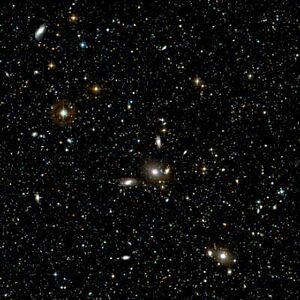Astronomy:Antlia Cluster
| Antlia Cluster | |
|---|---|
 | |
| Observation data (Epoch J2000) | |
| Constellation(s) | Antlia |
| Right ascension | 10h 30m 03.5s[1] |
| Declination | −35° 19′ 24″[1] |
| Brightest member | NGC 3268, NGC 3258 |
| Number of galaxies | 254 |
| Richness class | 0[2] |
| Bautz–Morgan classification | I-II[2] |
| Velocity dispersion | 444–591 km/s[3] |
| Redshift | 0.0087[4] |
| Distance (co-moving) | 40.7 Mpc (132.7 Mly)[5] |
| ICM temperature | ~2.0 keV[4] |
| Binding mass | ~3.3×1014[3] M☉ |
| X-ray luminosity | 3.4×1042 h75−2 erg/s (0.5-10.0 keV)[4] |
| Other designations | |
| Abell S0636 | |
The Antlia Cluster (or Abell S0636)[4] is a cluster of galaxies located in the Hydra–Centaurus Supercluster. The Antlia Cluster is the third-nearest to the Local Group after the Virgo Cluster and Fornax Cluster.[6] Antlia's distance from Earth is 40.5 megaparsecs (132.1 megalight-years) to 40.9 Mpc (133.4 Mly)[5] and can be viewed from Earth in the constellation Antlia.[5][7] The Antlia Cluster should not be confused with the Antlia Dwarf galaxy.[5]
Antlia is classified as a rare Bautz–Morgan type III cluster,[4][3] meaning it has no central dominant (cD) brightest cluster galaxy.[8] However, the cluster is dominated by two massive elliptical galaxies, NGC 3268 and NGC 3258, and contains a total of about 234 galaxies.[4][5] The cluster is very dense compared to other clusters such as Virgo and Fornax, thus containing early-type galaxies and a larger portion of dwarf ellipticals.[5][7][clarification needed] The cluster is split into two galaxy groups, the Northern subgroup gravitating around NGC 3268, and the Southern subgroup centered on NGC 3258.[5]
The cluster has an overall redshift of z = 0.0087, implying that the cluster is, like most objects in the Universe, receding from the Local Group.[4] Using the now-obsolete scientific satellite ASCA, X-ray observations show that the cluster is almost isothermal, with a mean temperature of kT ~ 2.0 keV.[4]
List of named objects in the Antlia Cluster
See also
References
- ↑ 1.0 1.1 "NASA/IPAC Extragalactic Database". Results for NGC 7424. http://nedwww.ipac.caltech.edu.
- ↑ 2.0 2.1 Abell, George O.; Corwin, Harold G. Jr.; Olowin, Ronald P. (May 1989). "A catalog of rich clusters of galaxies". Astrophysical Journal Supplement Series 70 (May 1989): 1–138. doi:10.1086/191333. ISSN 0067-0049. Bibcode: 1989ApJS...70....1A.
- ↑ 3.0 3.1 3.2 Hopp, U.; Materne, J. (July 1985). "The Antlia cluster of galaxies and its environment - The Hydra I-Centaurus supercluster". Astronomy and Astrophysics Supplement Series 61: 93–106. ISSN 0365-0138. Bibcode: 1985A&AS...61...93H.
- ↑ 4.00 4.01 4.02 4.03 4.04 4.05 4.06 4.07 4.08 4.09 4.10 4.11 4.12 Nakazawa, Kazuhiro; Makishima, Kazuo; Fukazawa, Yasushi; Tamura, Takayuki (August 2000). "ASCA Observations of a Near-by Cluster in Antlia". Publications of the Astronomical Society of Japan (Tokyo, Japan: PASJ) 52 (4): 623–630. doi:10.1093/pasj/52.4.623. Bibcode: 2000PASJ...52..623N.
- ↑ 5.0 5.1 5.2 5.3 5.4 5.5 5.6 Dirsch, B.; Richtler, T.; Bassino, L. P. (September 2003). "The globular cluster systems of NGC 3258 and NGC 3268 in the Antlia cluster". Astronomy and Astrophysics 408 (3): 929–939. doi:10.1051/0004-6361:20031027. Bibcode: 2003A&A...408..929D.
- ↑ 6.00 6.01 6.02 6.03 6.04 6.05 6.06 6.07 6.08 6.09 6.10 6.11 Smith Castelli, Analía V.; Bassino, Lilia P.; Richtler, Tom; Cellone, Sergio A.; Aruta, Cristian; Infante, Leopoldo (June 2008). "Galaxy populations in the Antlia cluster - I. Photometric properties of early-type galaxies". Monthly Notices of the Royal Astronomical Society 386 (4): 2311–2322. doi:10.1111/j.1365-2966.2008.13211.x. Bibcode: 2008MNRAS.386.2311S.
- ↑ 7.0 7.1 Smith Castelli, A. V.; Bassino, L. P.; Cellone, S. A.; Richtler, T.; Dirsch, B.; Infante, L.; Aruta, C.; Gómez, M. (December 2005). "Dwarf Galaxies in the Antlia Cluster: First Results". in I. Saviane. Proceedings of the ESO Workshop. ESO ASTROPHYSICS SYMPOSIA. Springer-Verlag (2007). p. 109. doi:10.1007/978-3-540-71173-5_17. ISBN 978-3-540-71172-8. Bibcode: 2007ggnu.conf..109S.
- ↑ Guthrie, B. N. G. (July 1974). "Radio emission associated with the brightest galaxies in clusters". Monthly Notices of the Royal Astronomical Society (MNRAS) 168: 15–20. doi:10.1093/mnras/168.1.15. A&AA ID: AAA012.160.002. Bibcode: 1974MNRAS.168...15G.
Further reading
- Burnham Jr., Robert (1978) Burham's Celestial Handbook Revised Edition Vol. 1 of 3. Dover Publications. New York ISBN:0-486-24063-0
External links
- The Antlia Cluster on WikiSky: DSS2, SDSS, GALEX, IRAS, Hydrogen α, X-Ray, Astrophoto, Sky Map, Articles and images
Coordinates: ![]() 10h 30m 03.5s, −35° 19′ 24″
10h 30m 03.5s, −35° 19′ 24″
 |

